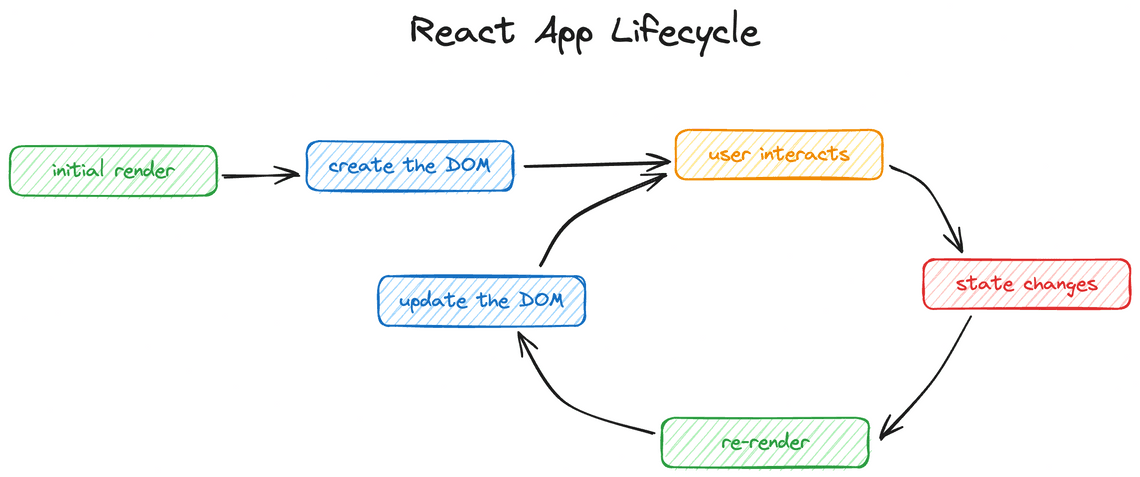Table Of Contents
🎯 Mastering UI State Management in React — A Complete Beginner’s Guide
React is all about building interactive, dynamic user interfaces. Whether you’re creating a simple counter app or a complex form, at the heart of every React app lies state—a mechanism for tracking data that changes over time.
In this blog, we’ll walk through the fundamentals of managing UI state in React, learn about hooks, control form inputs, derive values intelligently, and even optimize how state is initialized. Let’s dive in!
🔄 Understanding the UI Lifecycle in React
Dynamic applications update the UI based on user interaction. Here’s the basic flow:
Render → Setup the DOM → User Interacts → State Changes → Re-render → Update the DOM → Back to User Interaction

This loop is central to how React works. When a user does something (like clicking a button), your app should respond by updating its internal state, which then causes a re-render that updates the UI.
🪝 What Are Hooks?
React provides special functions called hooks that allow you to manage state and side effects inside functional components.
Here are some of the most common hooks:
useState— for managing component stateuseRef— for referencing DOM elements or valuesuse— for suspending/rendering with async data (experimental)useReducer— for complex state logicuseEffect— for side effects like fetching data
Each of these hooks behaves differently. For example, useState returns a pair: the current value and a function to update it.
🧮 Your First State: The Counter Example
Here’s a basic counter component using useState:
function Counter() {const [count, setCount] = useState(0)const increment = () => setCount(count + 1)return <button onClick={increment}>{count}</button>}
How It Works:
- We call
useState(0), which setscountto0initially. - When the button is clicked,
incrementis called, which updates the state viasetCount. - React re-renders the component with the new count.
👉 Note: The initial value passed to useState is only used once—on the first render. After that, React manages the value internally.
🔍 Controlling Form Inputs with State
To make UI truly dynamic, we often need to control input elements using state.
Let’s say you’re building a blog search page with an input field and checkboxes to filter results. You want to:
- Update the input value as the user types.
- Automatically fill the input when a checkbox is clicked.
This is called a controlled input, and you achieve it like this:
const [query, setQuery] = useState("")<input value={query} onChange={e => setQuery(e.target.value)} />
For checkboxes, update the input programmatically when the user clicks them:
<input type="checkbox" onChange={() => setQuery("example")} />
🧠 Deriving State Instead of Duplicating It
Let’s say you want to display whether a counter is odd or even. You could keep a second state like this:
const [count, setCount] = useState(0)const [isEven, setIsEven] = useState(true)
…but that leads to duplicate state, which can get out of sync.
💡 Better approach: derive the value from existing state.
const [count, setCount] = useState(0)const isEven = count % 2 === 0
Derived values keep your state logic clean and bug-free.
🔗 Initializing State from the URL
Imagine users want to share a search result page like:
https://example.com/search?query=cat+dog
You want to initialize your component’s state with the query from the URL. Here’s how:
const params = new URLSearchParams(window.location.search)const initialQuery = params.get('query') ?? ''const [query, setQuery] = useState(initialQuery)
Now the component will reflect the search query from the URL!
⚙️ Performance Tip: Lazy Initialization
What if computing the initial state value is expensive?
Instead of doing this:
const [val, setVal] = useState(expensiveComputation())
You can do this:
const [val, setVal] = useState(expensiveComputation)
Passing a function tells React to only run it once—on the first render. This is known as lazy initialization, and it can save performance in complex apps.
✅ Summary
Here’s a recap of what we learned about managing UI state in React:
| Concept | Description |
|---|---|
useState | Main hook for tracking and updating state in components |
| Controlled Inputs | Use state with value and onChange for dynamic form inputs |
| Derived State | Compute values from existing state instead of tracking them separately |
| Initializing from URL | Use URLSearchParams to grab query data on page load |
| Lazy Initialization | Pass a function to useState to avoid unnecessary computation |
📚 Further Learning
By understanding how React state works and applying these best practices, you’ll be able to build more reliable, user-friendly apps. Happy coding! 🚀
Let me know if you’d like this formatted for your blog CMS (e.g. Markdown with frontmatter, styled HTML, etc.) or tailored with code snippets for your specific use case.
